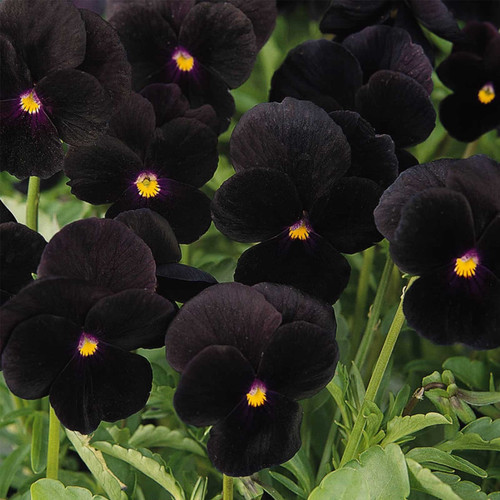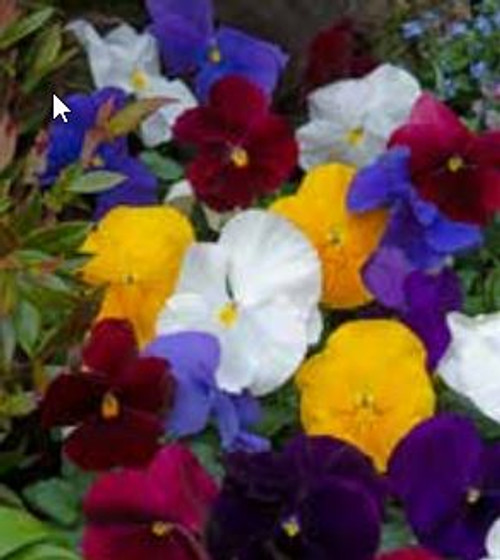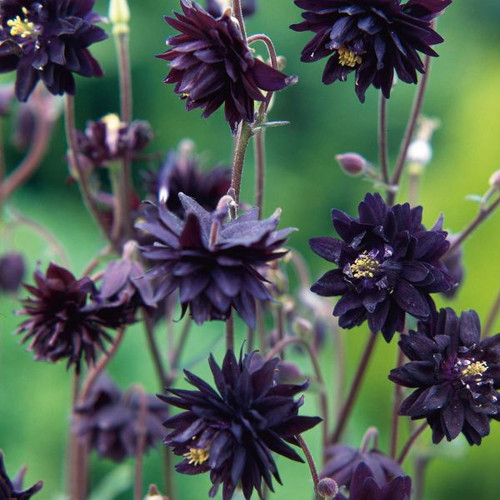Viola syn. Erpetion commonly known as Pansies, Pansy, Violet, Hooked-spur violet, Western dog violet, Great basin violet, Twin flowered violet, Dog Violet, Heath violet, Horned violet, Stream violet, Australian violet, Ivy leaved violet, Trailing violet, Labrador violet, Mountain Pansy, Marsh blue violet, English violet, Garden violet, Sweet violet, Bird’s foot violet, Crow foot violet, Larkspur violet, Common Blue Violet, Purple prairie violet, Wood violet, Woolly blue violet, Heartsease, Johnny jump up, Love in idleness, are annuals, biennials, evergreen, semi-evergreen and a few deciduous subshrubs found in varied habitats in temperate regions worldwide. Some are tufted or rhizomatous. They have mostly mid green leaves. Some South American species are rosette-forming and are very similar to sempervivums. Most are unscented, flower profusely over long periods from March to June and self seeds freely in late summer and early fall. Some are winter or spring flowering and ideal for planting with spring flowering bulbs. Many are informally referred to as garden pansies which come from the hybridization of V. tricolor, V. lutea, V. cornuta and other species.
USES: Rock garden, Scree beds, Borders, Alpine house, Containers, Bedding, Bee & Butterfly garden. Attracts small mammals and Songbirds, Can be used in salads or cooked, Flowers can be made into candies or jellies, Meadow garden, Small spaces, Woodland garden, Mass plantings, Edible gardens
TOLERATES: Black Walnut, Deer
Botanical Name: Viola cornuta ‘Back to Black’
Common Name: Horned Violet, Viola, Horned Pansy, Tufted Violet, Violets, Horn-Veilchen
Type: Spreading, rhizomatous, evergreen Perennial
Flower Color: Abundant, slightly fragrant, true Black flowers 1 ½ in. (4cm) across
Flowering Time: March to October
Foliage: ¾ to 2 in. (2-5cm) long
Plant Height: 8 in. (20cm)
Plant Width: 16 in (40cm) or more
Light Requirements: Full sun to Partial shade
Water Requirements: Moist
Soil Requirements: Well drained, fertile, humus rich soil. In a rock garden, grow in poor to moderately fertile, gritty, sharply drained soil. Protect from winter moisture. In an alpine house, use a mix of equal parts loam, leaf mold, and grit or tufa chips. Deadhead V. cornuta to keep compact.
USDA Zone: 6-8
AHS Heat Zone: 8-6
Misc: Can be grown as an annual or biennial. Tends to bloom better during cooler climates and stop flowering during hot weather. Plants require weeding until well established.
Sowing Instructions (Cliff Notes Version): Sow seed in containers in a cold frame in spring; for garden pansies, sow seed in late winter for early spring and summer flowering, or on site in summer for winter flowering.
Click here for Planting Instructions








